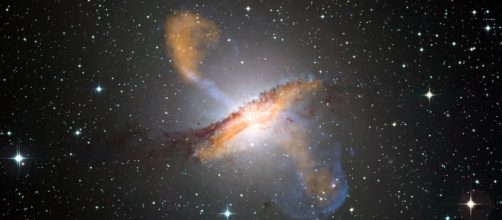Hubble Space Telescope captured the wavelengths of RAS 16399-0937, classified as a megamaser for the large luminosity that it exerts in space. The rosebud shaped galaxy´s image comprises observations made in various wavelengths by two of Hubble´s imaging instruments- an advanced camera and a spectrometer. The great resolution of the observations revealed two nucleuses within the galaxy. Even though, they are thousands of light years apart, both nucleuses interact, giving the galaxy a distinctive shape.
What is a megamaser?
Microwave amplification by stimulated emission of radiation (maser) is a natural occurring source of intense luminosity usually in the microwave spectrum.
Their luminosities may range in the thousandths of the luminosity of the sun, which is 100 million times more luminous than the masers found in the Milky Way. In order to produce a maser, it is necessary to have a population inversion or atoms or molecules in higher, excited states rather than in lower, producing photons by stimulated emission.
IRAS galaxy
IRAS 16399-0937 is a megamaser galaxy situated more than 370 light years away from earth. This rosebud shaped kind of galaxy comprises a double nucleus that lies nearly 11,000 light years apart from each other and is believed to be in the process of merging together. Both nucleuses are surrounded by swirling cosmic gas and dust interacting and giving the galaxy its distinctive appearance.
A black hole in IRAS 16399N
Even though the nucleus looks homogeneous, the processes there are distinct. While IRAS 16399S is a starburst cosmic region where some stars are in the process of formation, IRAS 16399N is a Low Ionization Nuclear Emission Region (LINER) where the emission of light stems mostly from weakly ionized atoms. This nucleus also comprises a massive black hole with 100 million masses that of the sun.
Most megamasers are hydroxyl (OH), that is to say, their spectral line amplified is due to a transition within the hydroxyl molecule. There are megamasers whose spectral line is amplified by water (H2O), methine (CH) and formaldehyde (H2CO).

